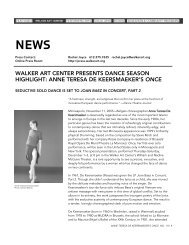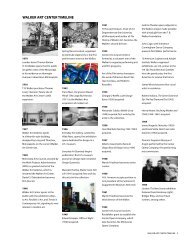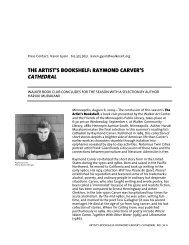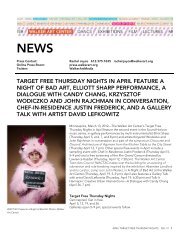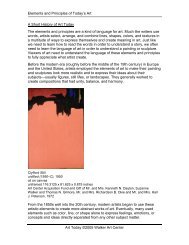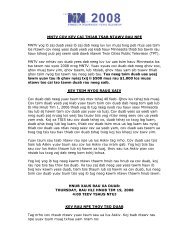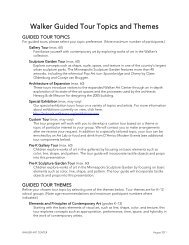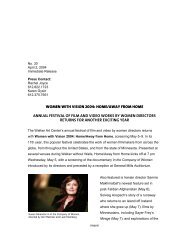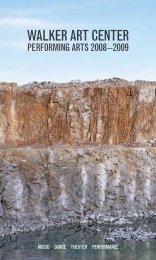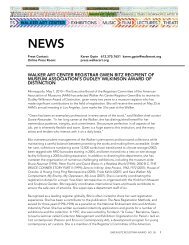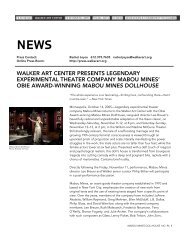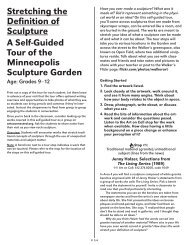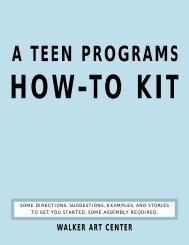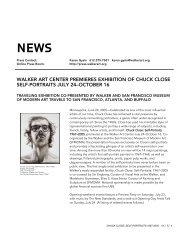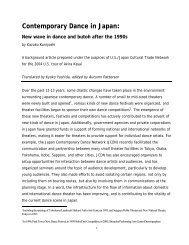new york artist sharon hayes makes the personal ... - Walker Art Center
new york artist sharon hayes makes the personal ... - Walker Art Center
new york artist sharon hayes makes the personal ... - Walker Art Center
You also want an ePaper? Increase the reach of your titles
YUMPU automatically turns print PDFs into web optimized ePapers that Google loves.
NEWS<br />
Press Contact: Karen Gysin 612.375.7651 karen.gysin@walkerart.org<br />
Online Press Room: press.walkerart.org<br />
NEW YORK ARTIST SHARON HAYES MAKES THE<br />
PERSONAL POLITICAL AT THE REPUBLICAN NATIONAL<br />
CONVENTION<br />
HAYES’ PUBLIC ACTION ON SEPTEMBER 1—REVOLUTIONARY LOVE 2:<br />
I AM YOUR BEST FANTASY—INCLUDES SPEAKERS FROM THE LOCAL<br />
QUEER COMMUNITY<br />
Sharon Hayes, In <strong>the</strong> Near Future, New York<br />
35mm slide installation, detail, 2005<br />
Photo courtesy Creative Time, New York<br />
Minneapolis, August 1, 2008—Creative Time with <strong>the</strong> <strong>Walker</strong> <strong>Art</strong> <strong>Center</strong><br />
and The UnConvention presents New York-based <strong>artist</strong> Sharon Hayes’<br />
Revolutionary Love 2: I Am Your Best Fantasy on Monday, September 1,<br />
on <strong>the</strong> grounds of <strong>the</strong> Minnesota State Capitol in St. Paul (times to be<br />
announced). Hayes will assemble some 100 people near <strong>the</strong> site of <strong>the</strong><br />
Republican National Convention in St. Paul for mass recitations of her<br />
script addressing political desire and romantic love. The project is<br />
commissioned by public art presenter Creative Time as part of its<br />
summerlong national public art initiative Democracy in America: The<br />
National Campaign, which includes a performance of Hayes’ Revolutionary<br />
Love 1: I Am Your Best Fantasy during <strong>the</strong> Democratic National<br />
Convention in Denver. Conflating grassroots political activism,<br />
performance art, queer <strong>the</strong>ory, and national politics, Hayes’ large-scale<br />
public performance will include speakers drawn from <strong>the</strong> local queer<br />
community. Three 10- to 20-minute readings will take place over <strong>the</strong><br />
course of two hours.<br />
Drawing on both <strong>the</strong> history of <strong>the</strong> Gay Liberation movement, which<br />
forged a <strong>new</strong> and deep relationship between love and politics, and <strong>the</strong><br />
current political moment, in which <strong>the</strong> war figures as a central element in<br />
<strong>the</strong> Presidential campaign, Revolutionary Love challenges simplistic<br />
oppositions between love and war. Specifically, Hayes is interested in <strong>the</strong><br />
militaristic aspect of groups that operated at <strong>the</strong> beginning of <strong>the</strong> gay<br />
rights movement, many of whom assumed aggressive, reactionary stances<br />
to culture at large. Where <strong>the</strong> classic slogan says “Make love not war,”<br />
SHARON HAYES NO. 94 1
Sharon Hayes, Everything Else Has Failed! Don't You Think<br />
It's Time for Love?<br />
documentation of performance, 2007<br />
Photo by Andrea Geyer<br />
Photo courtesy Creative Time, New York<br />
Hayes references <strong>the</strong> Sto<strong>new</strong>all-era Gay Liberation movement and its<br />
chant, “An army of lovers cannot lose.”<br />
Hayes’ performances are designed to mirror <strong>the</strong> spectacular nature of <strong>the</strong><br />
National Conventions. Reacting against <strong>the</strong> tendency of groups to polarize<br />
feelings about homosexuality for political gain, she describes <strong>the</strong>se<br />
performances as <strong>personal</strong> addresses to <strong>the</strong> power structure, or a group of<br />
people speaking <strong>the</strong>ir hearts as one.<br />
“I’m interested in inviting people to come personify a kind of flamboyant<br />
queerness, which could be both an embodied position or a costumed<br />
one,” says Hayes. “In this, my model is more <strong>the</strong> early Christopher Street<br />
Liberation Day Parades than <strong>the</strong> later pride parades. I’m really interested in<br />
<strong>the</strong> way in which queers in those early parades were demonstrating,<br />
wearing, flaunting <strong>the</strong>ir queerness to <strong>the</strong>mselves and only later to a larger,<br />
more hostile, more skeptical public for <strong>the</strong> first time. There’s something<br />
about this that strikes me as a kind of complicated flirtation that constitutes<br />
<strong>the</strong> power of ‘gay power’—a power that was at once empowerment,<br />
visibility, self-definition, and threat, much like Black Power but utilizing very<br />
different terms.<br />
“I’ve always been drawn to <strong>the</strong> spectacle events of <strong>the</strong> political<br />
conventions. I’ve spent hours and hours at <strong>the</strong> Museum of Television and<br />
Radio watching old conventions. I know that in <strong>the</strong> disparity or depravity of<br />
<strong>the</strong> current political landscape, <strong>the</strong>y tend to be huge and empty moments<br />
of unwarranted celebration. But I also think that as a ritual of mainstream<br />
national politics, we can’t help but converge on <strong>the</strong>m. It’s this convergence<br />
between candidates, politicians, delegates, protestors, media, television<br />
viewers, <strong>new</strong>spaper and blog readers, passersby, and residents of host<br />
cities that I find so compelling.”<br />
Sharon Hayes has produced challenging work in performance, video, and<br />
installation for more than a decade. Staging protests, delivering speeches,<br />
and organizing demonstrations, she creates interventions that highlight <strong>the</strong><br />
friction between collective activities and <strong>personal</strong> actions. Employing<br />
<strong>the</strong>ater, film, anthropology, linguistics, and journalism, her work engages<br />
history, politics, and public space. Her work has been shown at P.S.1<br />
Contemporary <strong>Art</strong> <strong>Center</strong>, <strong>the</strong> Whitney Museum of American <strong>Art</strong>’s<br />
Independent Study Program, The New Museum of Contemporary <strong>Art</strong> in<br />
New York, Los Angeles Contemporary Exhibitions, among o<strong>the</strong>r national<br />
and international exhibition spaces.<br />
Creative Time<br />
After 34 years of New York–based projects, Democracy in America continues<br />
Creative Time’s national program, which was launched with Paul Chan’s Waiting for<br />
Godot in New Orleans in 2007. By bringing Democracy in America to communities<br />
around <strong>the</strong> nation, Creative Time deepens its commitment to <strong>artist</strong>s working<br />
outside New York City, sharing its belief in <strong>the</strong> transformative power of public art<br />
with <strong>the</strong> broadest possible audience. During <strong>the</strong> lead-up to <strong>the</strong> 2004 election<br />
season, Creative Time presented <strong>the</strong> Freedom of Expression National Monument,<br />
SHARON HAYES NO. 94 2
Sharon Hayes, In <strong>the</strong> Near Future, New York<br />
35mm slide installation, detail, 2005<br />
Photo courtesy Creative Time, New York<br />
a giant megaphone for public address, and Jenny Holzer’s For New York City, in<br />
which <strong>the</strong> <strong>artist</strong>’s truisms—including “ABUSE OF POWER COMES AS NO SURPRISE”—were<br />
pulled by airplanes over <strong>the</strong> skies of New York City. Recent projects include Tribute<br />
in Light, which served as a gesture of hope and healing after 9/11; Doug Aitken:<br />
Sleepwalkers, a film projected on <strong>the</strong> Museum of Modern <strong>Art</strong>, NY; and Who Cares,<br />
a series of projects that explored art and social action.<br />
Funding<br />
Creative Time is funded through <strong>the</strong> generous support of corporations,<br />
foundations, government agencies, and individuals. It gratefully acknowledges<br />
public funding from <strong>the</strong> New York City Department of Cultural Affairs; <strong>the</strong> New<br />
York State Council on <strong>the</strong> <strong>Art</strong>s, a State agency; New York City Council Speaker<br />
Christine C. Quinn; and New York State Senator Thomas K. Duane.<br />
Additional support for Democracy in America: The National Campaign is<br />
generously provided by Altria, American <strong>Center</strong> Foundation, The Andy Warhol<br />
Foundation for <strong>the</strong> Visual <strong>Art</strong>s, Emily Glasser and Billy Susman, Elizabeth Firestone<br />
Graham Foundation, Agnes Gund, Fifth Floor Foundation, The Peter Norton Family<br />
Foundation on behalf of Eileen Harris Norton, and <strong>the</strong> National Endowment for <strong>the</strong><br />
<strong>Art</strong>s.<br />
The UnConvention (www.<strong>the</strong>unconvention.com)<br />
The UnConvention is a non-partisan collective of citizens who have come toge<strong>the</strong>r<br />
to create a forum in which to promote <strong>the</strong> democratic and free exchange of ideas<br />
on important issues. It exists as a counterpoint to <strong>the</strong> highly scripted and<br />
predetermined nature of <strong>the</strong> contemporary presidential nomination process and<br />
convention.<br />
The UnConvention was initiated by Nor<strong>the</strong>rn Lights, a <strong>new</strong> Twin Cities-based arts<br />
agency with support from <strong>the</strong> McKnight Foundation. Lead partners for <strong>the</strong><br />
UnConvention are Intermedia <strong>Art</strong>s and <strong>the</strong> <strong>Walker</strong> <strong>Art</strong> <strong>Center</strong>. Local participating<br />
organizations include, among o<strong>the</strong>rs: Forecast Public <strong>Art</strong>s, Form + Content, The<br />
Liberty Parade, Minneapolis College of <strong>Art</strong> and Design, The Minneapolis<br />
Foundation, Sandbox Studios, Twin Cities Youth Media Network, Spark24, Spark<br />
Festival The UpTake, <strong>the</strong> University of Minnesota, and <strong>the</strong> Weisman <strong>Art</strong> Museum.<br />
National Partners include Creative Time, a New York-based innovative public arts<br />
organization, and Provisions Library, a social change learning resource center<br />
based in Washington, DC.<br />
<strong>Walker</strong> <strong>Art</strong> <strong>Center</strong> programming is made possible by its Premier Partners: Best Buy,<br />
General Mills, Piper Jaffray, Target, and Star Tribune.<br />
The <strong>Walker</strong> <strong>Art</strong> <strong>Center</strong> is located at 1750 Hennepin Avenue—where Hennepin meets<br />
Lyndale—one block off Highways I-94 and I-394, in Minneapolis.<br />
For public information, call 612.375.7600, or visit walkerart.org.<br />
SHARON HAYES NO. 94 3



